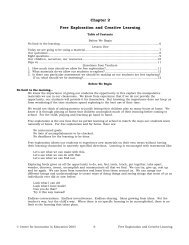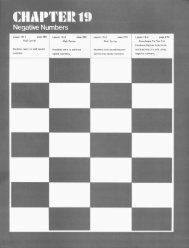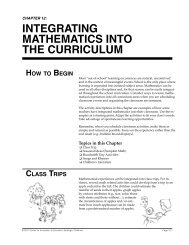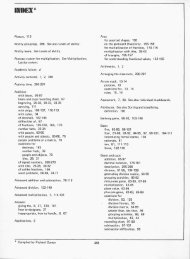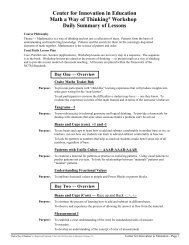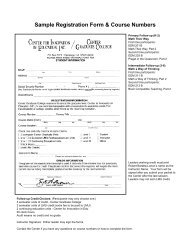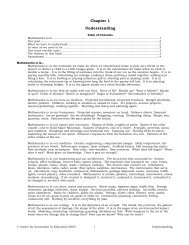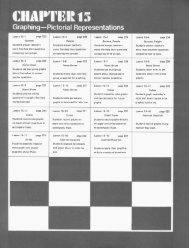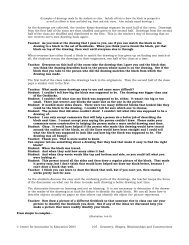Chapter 11 Fractions, Ratios, Money, Decimals and Percent
Chapter 11 Fractions, Ratios, Money, Decimals and Percent
Chapter 11 Fractions, Ratios, Money, Decimals and Percent
You also want an ePaper? Increase the reach of your titles
YUMPU automatically turns print PDFs into web optimized ePapers that Google loves.
Rate tables .........................................................................................................................267Lesson TenFocus on an underst<strong>and</strong>ing ................................................................................................268One is what we say it is, again............................................................................................268Where the decimal goes....................................................... ...............................................269New equivalencies..............................................................................................................270A rule for multiplying..........................................................................................................270What the answers mean......................................................................................................271Ten by ten.................. ........................................................................................................272Lesson ElevenNot equivalent ....................................................................................................................273The difference ....................................................................................................................2743Calculator key.................................................... ................................................................274Knowledge we can refine.....................................................................................................274Lesson TwelveFast finishers.....................................................................................................................276Vending machine......................................................................................................... .......277Do we know to teach the parents? .......................................................................................277Milk money ........................................................................................................................278Restaurant lunch................................................................................................................278Stores ........................................................... .....................................................................279Think money ......................................................................................................................279Assessments ......................................................................................................................280SummaryTwelve lessons ...................................................................................... .............................280Questions from Teachers1. How do we assess for fractions? What kind of assessments might we use? .....................2802. In Lesson Ten, for the multiplication problems on the geoboard, the fractions in the answerswere not reduced. Why not? Isn't the teaching of the reducing of fractions an extension ofequivalencies?..............................................................................................................281<strong>Fractions</strong>...<strong>Fractions</strong> are:Before We BeginAreas of shapes.Parts of groups.<strong>Money</strong>'s change.<strong>Ratios</strong> of numbers.<strong>Decimals</strong>.Fragments.Equal shares.Measurements of time.Partial lengths, weights, or heights.Costs per unit sold.Averages.<strong>Percent</strong>s.Portions.Numbers waiting to divide.Parent speaking to two children about to share a single piece of cake: One of you can cut thepiece of cake; the other one can choose his piece first.Children are familiar with fractions long before they come to school. How carefully will the cutter cutthe cake? Do the children dividing the cake know the piece each one receives is called a half? Is thereany question that the child doing the cutting <strong>and</strong> the child choosing first underst<strong>and</strong> the meaning ofdividing evenly?<strong>Fractions</strong> are a part of children's lives before children even know that fractions are a part of math. Ourhope is that the lessons that we teach leave our students as comfortable with fractions as our studentswere before our lessons began.Guides <strong>and</strong> nothing more..."Lift the Bowl" is a game in Mathematics Their Way (pages 181-183) in which the first player selects abeginning number of blocks. This first player then hides some of the blocks beneath the bowl <strong>and</strong> putsthe rest on top. The second player, when told the beginning number, looks at the blocks on top <strong>and</strong>says how many blocks are hidden. For the illustration below, five blocks is the starting number.(illustration <strong>11</strong>-0-1)(A bowl from the bowl game with three blocks on top.)© Center for Innovation in Education 2003 240 <strong>Fractions</strong>, <strong>Ratios</strong>, <strong>Money</strong>, <strong>Decimals</strong> <strong>and</strong> <strong>Percent</strong>
Playing the game gives young children the opportunity to think about combinations of two numbers thatadd to make another. In this example, the student learns "Three <strong>and</strong> two make five."A visitor unfamiliar with "Lift the Bowl" was visiting a room where children were playing the game. Thefirst two children she observed were playing it a different way. The starting number of blocks was five,but one child had placed a block on the top of the bowl <strong>and</strong> held two more blocks in his h<strong>and</strong>.First student: There is a block on top <strong>and</strong> two more in my h<strong>and</strong>. How many blocks are hidingunderneath?Second student: Two.When the visitor had finished her walk around the room she asked the teacher to tell her the name ofthe wonderful game the first two children had been playing. The teacher said, "Describe the game, <strong>and</strong>I'll tell you what it's called." When the visitor described the game, the teacher said, "Oh no! If I hadseen the children playing it that way, I would have stopped them at once. That isn't what Math TheirWay says to do at all!"Can a book anticipate every learning experience we might face? Can a book tell us what is math <strong>and</strong>what is not? Books should no more prescribe a path of learning from which we must not deviate thanwe should prevent students from going beyond what we have told them to do. Can we teach thinking ifno thinking is allowed?The lessons that follow are guides for teaching about fractions <strong>and</strong> their decimal cousins. They areguides <strong>and</strong> nothing more.PurposeSummaryMaterialsTopicLesson OneLearn about fractions informally. Learn the words to say <strong>and</strong>the numbers to write.Students explore Power Blocks, guided by the questions thatwe ask. We teach words <strong>and</strong> numbers that describe thefractions.Power Blocks, recording paper, blackline matrix.Freely exploring, with learning directed through questionsasked.Which pieces make into other pieces?TopicTopic S-1 = 1, T-1 = 1.Topic S-5 = 1.Topic Matrix for everything = 1.TopicLearning the words to say for fractions.Playing with the blocks...Principal to kindergarten teacher: Try these Power Blocks with the children in your room <strong>and</strong> seehow you like them.Two weeks later, the kindergarten teacher returns the blocks to her principal.Kindergarten teacher to principal: These blocks must be meant for much older children. My kidscould not find anything to do with them but play.What do children learn by playing with the blocks? As they free explore, they create learning forthemselves. They form patterns <strong>and</strong> make connections. They develop beginning number skills. Theysort <strong>and</strong> classify <strong>and</strong> exp<strong>and</strong> the language that they use. They form concepts of shapes <strong>and</strong> theirrelationships to one another as they construct geometrically. They measure as they build.Our students' first fraction lesson is playing with the blocks. We channel their learning by thequestions that we ask:How many different pieces are in your set?What does the word different mean? Different size? Different shape?Do the codes written on the pieces give us any clue?What meanings do the codes have for us?Is there a pattern to the numbers <strong>and</strong> the letters?Which of the same pieces make into larger sames? Which do not?© Center for Innovation in Education 2003 241 <strong>Fractions</strong>, <strong>Ratios</strong>, <strong>Money</strong>, <strong>Decimals</strong> <strong>and</strong> <strong>Percent</strong>
(illustration <strong>11</strong>-1-1)(Show what is meant by "larger sames".)Which two of any piece make into a bigger piece within the set? Which three? Which four?(illustration <strong>11</strong>-1-2)(Show examples of Power Blocks used to make bigger pieces in the set.)How many different ways to make a piece? Trace the ways you find.(illustration <strong>11</strong>-1-3)(Show what is meant by "how many ways" so that it is clear that for this question the pieces do not allhave to be the same size. Show examples in blocks <strong>and</strong> traced.)If the S-1 square has an area of one, how many other shapes (or pieces) can you find an area for?Keep track of all the areas that you find. Keep a record of your proofs.(illustration <strong>11</strong>-1-4)(Show the S-1 square <strong>and</strong> other shapes with the proofs of their areas given.)(illustration <strong>11</strong>-1-5)(As a separate illustration, show the indirect proof necessary to prove the area of the S-2 shape <strong>and</strong> thenthe S-4. Comment that these pieces <strong>and</strong> the long thin triangles <strong>and</strong> rectangles are in the set for just thiskind of proof.)What happens if we now say the T-1 piece has an area of one? Keep track of all the areas that youfind. Keep a record of your proofs.(illustration <strong>11</strong>-1-6)(Show the T-1 triangle <strong>and</strong> other shapes with the proofs of their areas given.)Fraction lesson, too...What do children learn by playing with the blocks? They learn about fractions as naturally as theylearn about fractions outside of school.Teacher: Today, we will say the S-5 square has an area of one. What is the area of all the otherpieces now? Keep track of all the areas that you find. Keep a record of your proofs.(illustration <strong>11</strong>-1-7)(Show the recordings done three ways: by tracing, by writing the formulas underneath... i.e. T - 5 + T - 5= S - 5 <strong>and</strong> by writing out the fractional equivalents.)A rule that we present...(illustration <strong>11</strong>-1-8)(Show three blocks formed in the same shape as the S-5 square. The three pieces are a half (R-4) <strong>and</strong> twofourths (two S-3's).)The largest square is one. Does that make each of the three pieces above equal to a third? We knowthat it does not. A child dividing something with a friend may comment that the other person got thebigger half. Bigger halves are not a part of the fractions that we teach. The fractions that equal thesquare in the illustration above are 1/4 + 1/4 + 1/2, not 1/3 + 1/3 + 1/3. A rule to help our studentsunderst<strong>and</strong> fractions is that, for fractions to have the same value, every part must be of equal size.(illustration <strong>11</strong>-1-9)(S-5 made of two R-4's. S-5 made of four S-3's. Label the R-4's as halves. Label the S-3's as fourths. S-5 made of one R-4 <strong>and</strong> two S-3's, with each fractional part correctly labeled.)A different one...Teacher: What happens if we pick a different piece to have an area of one? How many differentsizes can we say has an area of one?(illustration <strong>11</strong>-1-10)(Show a matrix of the value of the different pieces as the value of "one" is changed.)Teacher: If this piece is one-fourth the area of one, which piece would have an area of one?© Center for Innovation in Education 2003 242 <strong>Fractions</strong>, <strong>Ratios</strong>, <strong>Money</strong>, <strong>Decimals</strong> <strong>and</strong> <strong>Percent</strong>
(illustration <strong>11</strong>-1-<strong>11</strong>)(Show the T-3 triangle. Print the T-3 label next to it.)Teacher: Can more than one piece have an area of one when T-3 is one-fourth?For each question we ask, we encourage our students to reason out answers <strong>and</strong> to share theirreasoning with everyone in class.Know the words to say...(illustration <strong>11</strong>-1-12)(S-5 square with two T-5 triangles next to it formed into a square the same shape.)Teacher: How many equal parts make up this whole?Students: Two.Teacher: Does anyone know what we call each of the equal parts?Student: A half.If no one knows, we teach the name to use.Teacher: There are two parts. We write the fraction for one part like this:12The bottom number is how many equal pieces together make up the whole. The top number is thenumber of pieces that we have.(illustration <strong>11</strong>-1-13)(S-5 square with four S-3 squares next to it formed into a square the same shape.)Teacher: How many equal parts make up this whole?Students: Four.Teacher: Does anyone know what we call each of the equal parts?Student: Fourths.If no one knows, we teach the name to use.Teacher: Here's the fraction for a fourth.What does the bottom number mean?Student: How many pieces to make the whole.Teacher: What does the top number mean?Student: That's for the one little piece.Teacher: Let's try another one.14We do not worry about reducing fractions to their lowest denominators. We leave 2/4 as 2/4 for now.Proving blocks...High school students learn about axioms, theorems <strong>and</strong> proofs in geometry. An axiom is a statementthat is accepted as true without proof. A theorem is a statement that can be proved.Axiom: The S-1 square has an area of one.Theorem: Find the areas of the other shapes. Keep a record of your proofs.Each proven area is a theorem that follows from the axiom.New axiom: The T-1 triangle has an area of one.When the axiom is changed, do the theorems change as well?© Center for Innovation in Education 2003 243 <strong>Fractions</strong>, <strong>Ratios</strong>, <strong>Money</strong>, <strong>Decimals</strong> <strong>and</strong> <strong>Percent</strong>
Not right...Teacher: What is the height of these triangles?(illustration <strong>11</strong>-2-7)(Show one acute triangle <strong>and</strong> one obtuse triangle. Show that, for the acute triangle, the height is theperpendicular line from the base to the highest point. Show that, for the obtuse triangle, the height isalso the perpendicular line from the base to the highest point, but we need to extend the base beyondthe triangle to find that perpendicular point. The height is how tall the triangle is, straight up from theline the base is on.)Teacher: Find the areas for all the geoboard triangles that you can, even the ones that are notright triangles. Record their bases, heights <strong>and</strong> areas. Prove the areas that you find.The rule is that the base for each triangle that you make has to be on the bottom row of nails.(illustration <strong>11</strong>-2-8)(Several triangles on geoboards <strong>and</strong> recorded on paper. With their bases, heights <strong>and</strong> areas recorded in atable.)The bases must be on the bottom row of the geoboards because measuring triangles made another wayis more difficult. Which side of the triangle below shall we say is the base? What might be its height?What might be the measurements for each?(illustration <strong>11</strong>-2-9)(Show a triangle on a geoboard with no sides parallel to the bottom row <strong>and</strong> no side lengths easilycounted by nails touched.)Mathematics is simple <strong>and</strong> basic <strong>and</strong> straightforward. The rules we add are designed to keep it so.Teacher: Can you find a pattern in the areas of your triangles that might help you predict theareas for all triangles?Is the pattern you find now anything like the pattern you found for right triangles?Four triangles...Teacher: Here are four triangles I have made.(illustration <strong>11</strong>-2-10)(First triangle: Right triangle with a base of one <strong>and</strong> a height of four. The base extends from the first tothe second nail of the bottom row. The height extends from the second nail of the bottom row to thesecond nail of the top row. The second triangle is exactly the same as the first except that the top of thetriangle is now the third nail of the top row. The third triangle is exactly the same as the second exceptthat the top of the triangle is now the fourth nail of the top row. The fourth triangle is exactly the sameas the first except that the top of the triangle is now the fifth nail of the top row.)Teacher: What is the base of each of these triangles?Students: One.Teacher: What is the height of each of these triangles?Students: Four.Teacher: What are the areas of each of these triangles? Work with a partner to find out.Is there a pattern to be seen?Our students learn...When we ask our students to prove the areas of shapes on their geoboards, our students learn to usetheir problem-solving skills. They learn to find areas <strong>and</strong> prove the areas that they find. They learnfrom one another a variety of approaches to discovering new solutions. They learn from us techniquesthan might not occur to them. They learn that there are patterns in the answers to our questions. Theyalso learn that using fractions at school is as easy <strong>and</strong> as natural as cutting cake at home.Lesson ThreePurposeLearn that fractions are special numbers describingpart/whole relationships. Learn to add <strong>and</strong> subtract simplefractions.© Center for Innovation in Education 2003 246 <strong>Fractions</strong>, <strong>Ratios</strong>, <strong>Money</strong>, <strong>Decimals</strong> <strong>and</strong> <strong>Percent</strong>
SummaryMaterialsTopicTopicTopicHomeworkStudents learn to use people in the room to create simplefractions, then addition <strong>and</strong> subtraction problems. They alsolearn to create stories to accompany fractional numbers.Students in the room, chalkboards, paper.<strong>Fractions</strong> are created with people in the class.Students create their own addition problems.Students create their own subtraction problems.What problems can our students create with the people intheir home?People fractions...Teacher: How many people are in our class today? Count all the students in the room. Count mein as well.Students: Thirty.Teacher: What fraction of the people in the room are each of you?The thirty in the answer given by the students represents the thirty people in the room, or the whole.But fractional numbers represent two different concepts at once—the whole <strong>and</strong> the part.Teacher: Altogether, we are one whole class. The fraction of the class we are is the part we are ofthe whole. Thirty people are in the room. I am one of them. So, I am one-thirtieth of thepeople in the room. One out of thirty, or one-thirtieth, is written one over thirty, like this:130What fraction of the people in the room are you?When the students know what fraction, or part, of the class they are, the teacher changes what is calledthe whole <strong>and</strong> asks again.Teacher: Now, your row is one whole row.How many people are there in your row?What fraction of your row are you?Use your chalkboards to show me how you think you write the fraction that you are.Easy to say...Eventually, our students will have to know the formal names for every fraction that they say or write:one over seven is one-seventh; one over two is one-half. But eventually does not mean right now. Wecan start our students out with fractions that are easy to say <strong>and</strong> easy to write.Parts <strong>and</strong> wholes are not difficult to write. The number on the bottom (the denominator) is the numberof the whole. The number on the top (the numerator) is the number for the parts. If we read the fractionas parts over wholes, parts <strong>and</strong> wholes are not difficult to say. One-eighth, one out of eight, or one overeight—if our students underst<strong>and</strong> the meaning of the fraction, we accept anyway they say it at the start.Adding people fractions...Teacher: I am going to make up an addition problem for fractions. Cindy, how many people are inyour row?Student: Seven.Teacher: What fraction of your row are you?Student: One out of seven.Teacher: How would you write that?Student: One over seven.Teacher: Show me on your chalkboard, please.Student: 1/7Teacher: What fraction of your row is Nicole?Student: She's one over seven, too.Teacher: What fraction of your row are you <strong>and</strong> Nicole together?Student: Two over seven.Teacher: We would write the addition problem like this:1 + 1 = 27 7 7© Center for Innovation in Education 2003 247 <strong>Fractions</strong>, <strong>Ratios</strong>, <strong>Money</strong>, <strong>Decimals</strong> <strong>and</strong> <strong>Percent</strong>
Students: 3/6 - 2/6 = 1/6The students record the fraction problems for subtraction on their individual chalkboards until theteacher feels they underst<strong>and</strong> the process well enough to begin creating problems for themselves.Teacher: Now, I want you to make up your own fraction problems for people. You may worktogether or by yourself. You may write about the people in the room or people from any otherplace you wish. You may make up subtraction problems or addition problems or problems thathave addition <strong>and</strong> subtraction mixed in.Please say what the whole group is before you write the fractions. You may either write a storyor draw a picture to go along with each problem you create.Let people help...<strong>Fractions</strong> are special numbers that represent two concepts at once—the whole <strong>and</strong> the part. Studentswho are old enough to know that they are individuals at the same time that they are part of a wholegroup, are old enough to underst<strong>and</strong> what people fractions mean.Unless we are alone, we are in a group. We can ask people-fraction questions st<strong>and</strong>ing in the lunchline, waiting for the school bus, or sitting in a row of seats impatient for the assembly to begin. Peoplefractionquestions can go home. What fraction of each family is each child? What fraction of eachfamily is girls? What fraction is boys? What other people-fraction questions can our students ask athome? People fractions follow us wherever we go.Learning about fractions is not something we save for an upper grade. We use Power Blocks <strong>and</strong>geoboards to help us make fractions a natural part of our students' learning from their earliest years inschool. We let people help us, too.Lesson FourPurposeSummaryMaterialsTopicHomeworkLearn to be aware of fractions in life.We ask our students to think about the sharing, cutting <strong>and</strong>dividing fractions in their lives.None.Teacher lead discussion on the sharing, cutting <strong>and</strong> dividingthat lead to fractions in our lives.Students bring examples from home to school to share.Fifty-four marbles...54 ÷ 4 is a division problem. The answer that a calculator gives is 13.5. But mathematics is more thannumbers on a page or the answer that a calculator finds.Teacher: Four children have 54 marbles to share among themselves. How many marbles will eachchild receive? Please be prepared to explain your answer to the class.Patrick: The answer is 14 because when I do it on my calculator, I get 13.5, but we are supposedto round up when we get a .5, so its 14.Calculators give us answers for the arithmetic that we do, but are calculators any use in giving studentsan awareness of what the numbers mean? Patrick has learned to round up when he sees .5, but has helearned to think about what the numbers mean?Teacher: Patrick, what does your calculator say fourteen times four is?Patrick: 56.Teacher: Then if I said to you that four children each have fourteen marbles, how many marbleswould they have altogether?Patrick: 56.Teacher: But the first problem I gave you said the four children have only 54 marbles, not 56.You would need to have started with 56 to give each child fourteen.Rounding is a useful skill to know. Knowing when to round <strong>and</strong> when to not is another useful skill.Jesse: You don't round. The answer is just 13.5. Everybody gets 13 <strong>and</strong> a half.Teacher: How do you propose to give anyone half a marble?Jesse: Hit the extra marbles with a hammer?Teacher: Is that really how you would share any extra marbles that you had?Jesse: No.© Center for Innovation in Education 2003 249 <strong>Fractions</strong>, <strong>Ratios</strong>, <strong>Money</strong>, <strong>Decimals</strong> <strong>and</strong> <strong>Percent</strong>
Aaron <strong>and</strong> Danielle: Each child gets thirteen marbles. Then they play rock-scissors-paper to seewho gets the two left over. So three children get thirteen marbles <strong>and</strong> one gets fifteen.Teacher: That way seems like it would work. Who has another way that the children mightshare?The teacher questions each student's explanation to see if the students underst<strong>and</strong> the numbers. Thenthe teacher uses the numbers 54 ÷ 4 to ask a different question.Teacher: Four children have 54 cookies to share among themselves. How many cookies will eachchild receive? Please be prepared to explain your answer.What is the difference between fifty-four cookies <strong>and</strong> fifty-four marbles? Individual marbles cannot bebroken up <strong>and</strong> shared. Individual cookies can. Mathematics is more than numbers on a page.Dividing, cutting, sharing...Teacher: What are examples of sharing in your life?Sharing food <strong>and</strong> drinks.Sharing toys.Sharing colored pencils or crayons.Sharing math materials in class.Sharing clothes.Sharing the swing at recess.Sharing secrets.Sharing money.Sharing comic books.Sharing combs <strong>and</strong> brushes.Sharing lipstick.Sharing rides.Sharing answers for homework.Sharing answers secretly for a test.Sharing ideas.Sharing prizes won.Sharing with the class.Teacher: We know that c<strong>and</strong>y bars can be shared fractionally. Can comic books? Can pencils?Which things do we divide using fractions <strong>and</strong> which do we divide another way?Can you explain your answer?Teacher: What are examples of things you can cut?Cutting cakes <strong>and</strong> pies.Cutting firewood.Cutting class.Cutting up in class.Cutting glass.Cutting grass or hay.Cutting someone down.Cutting hair.Cutting fingernails.Cutting out paper dolls.Cutting out the pattern for a shirt or dress.Cutting with a knife.Cutting down a tree.Cutting back on spending.Cutting through the water.Cutting pictures from a magazine.Cutting folded paper into snowflake designs.Cutting diamonds.Cutting cattle with a horse.Teacher: We know that cut up cakes <strong>and</strong> pies can be described fractionally. Can cutting hair?Which of the things that we can cut can be described with fractions <strong>and</strong> which cannot?Explain your answers.Teacher: What are examples of when you might use your skills of division?© Center for Innovation in Education 2003 250 <strong>Fractions</strong>, <strong>Ratios</strong>, <strong>Money</strong>, <strong>Decimals</strong> <strong>and</strong> <strong>Percent</strong>
Dividing the arithmetic problems on the workbook page.Dividing to see if the multiplication answer was right.Dividing h<strong>and</strong>sful of squares into groups.Dividing portions in the cafeteria.Dividing into teams.Dividing to find averages.Dividing up the chores.Dividing up the Sunday paper.Dividing miles into gallons to see the mileage for the car.Dividing up the l<strong>and</strong>.Dividing up the loot.Dividing up the time.Dividing up the day.Dividing to find the cost of one.Dividing to find your share.Teacher: We know that we can divide squares into groups <strong>and</strong> if the groups don't divide evenly,the remainder is a fraction. Would dividing people into teams ever leave a fraction?Which of the things that we can divide might have fractions in their answers at leastsometimes? What would the fractions be? Which things never have fractions in theiranswers?Explain your answers.<strong>Fractions</strong> everywhere...We ask our students to think about fractions in school. How do we help our students to think aboutfractions at home?Teacher: Your homework assignment for tonight is to find examples of fractions <strong>and</strong> bring themwith you tomorrow when you come to school.You may bring in your examples in any way you can. Cut them out (ask permission first!), writethem up, draw them, or bring them in your head.Where do you think you might look to find examples? Where are fractions used?If our students do not know where to look, we provide some clues. Examples come from the sharing,cutting <strong>and</strong> dividing discussions we have had in class. Where else might our students look at home?In newspapers, magazines <strong>and</strong> cookbooks. On packages for foods <strong>and</strong> drinks. Looking meanslistening, too. What fractions are used on the radio, on TV, or in conversations with relatives?Examples can come from places outside the home. Store advertising signs, sizes for shoes <strong>and</strong> clothes,product names, street addresses, distances to freeway exits. Every situation that our students find canbe the inspiration for a hundred situations more.The awareness we create...The object of this lesson is not the answers that we find, it is the awareness we create. <strong>Fractions</strong> areeverywhere around.We have three half-gallon bottles of soda to share for our party this afternoon. We also have papercups for everyone. Can we figure out in advance if three bottles hold enough soda to giveeverybody in class at least one full cup? If any soda were left, how much would each child getfor seconds? If three bottles are not enough, how many more will we need?How should we cut Aaron <strong>and</strong> Kyle's birthday cake so that everyone gets a piece? What fraction ofthe cake will each piece be? Should we cut it differently, so that there will be cake left over forseconds? What fraction would these pieces be?How shall we divide the class to have four teams for P. E. today? Will the teams come out evenly? Iffour teams does not give each team the same number of players <strong>and</strong> we want equal teams, howmany teams should we have?Julie found the fraction 1/3 in the newspaper for a one-third off sale. How could we tell the priceof something that is now one-third less than its original price?We ask questions for awareness. We create problems that are real. We take the risk of not knowingwhere the lesson may be going <strong>and</strong> let the lesson take us where it leads. Some problems may lead towork with fractions. Some may not. All involve thinking about how to use mathematics. All involveconnecting math to life.© Center for Innovation in Education 2003 251 <strong>Fractions</strong>, <strong>Ratios</strong>, <strong>Money</strong>, <strong>Decimals</strong> <strong>and</strong> <strong>Percent</strong>
Teachers ask questions for different reasons in the United States <strong>and</strong> in Japan. In theUnited States, the purpose of the question is to get an answer. In Japan, teachers posequestions to stimulate thought. A Japanese teacher considers a question to be a poorone if it elicits an immediate answer, for this indicates that students were notchallenged to think.J. W. Stigler & H. W. Stevenson, How Asian Teachers Polish Each Lesson to Perfection,American Educator, Volume 15, Number 1, Spring 1991.Is there a particular method for calculating the answers that we should teach our students? Can ourstudents figure out if three bottles of soda are enough to share? Can they decide how to cut a cake sothat everybody gets a piece? Can the children in our room divide themselves into teams? Can theyshow us what it means to take one-third off?Answers are not the goal. Thinking is. <strong>Fractions</strong> are something that we think about.The assessment...If we do not have soda bottles, or cakes, our students show us how they would divide, cut, or sharewith manipulatives. Unifix Cubes, Power Blocks <strong>and</strong> water from the fountain are available for ourstudents to act out how they might divide, cut, or share. The assessment for each problem that ourstudents do is in the proofs they offer for the answers that they find.What is the assessment for a lesson that may lead us in directions that we did not plan?Teacher: Write down everything you have learned about fractions. If drawings help you showwhat you have learned, add drawings to the writing that you do. You may use your spellingnotebooks if you are not sure how to spell a word.Assessments do not have to involve special problems that we create. Assessments can be as simple asasking our students to tell us what they think they know. As we read their statements, we can see whathas been learned <strong>and</strong> what we should teach next.Lesson FivePurposeSummaryMaterialsTopicTopicHomeworkLearn about equivalencies.Students use paper folding <strong>and</strong> Power Blocks to generate listsof equivalencies, which they then search for patterns.Paper, Power Blocks, chalkboards.Folding paper, recording the equivalencies formed.Finding <strong>and</strong> recording Power Block equivalencies.Paper folding can be shared at home.Painting the house...Three parents chatting in the st<strong>and</strong>s at their children's hockey game:First parent: The older my kids get, the harder it is for me to help them with their homework.Did you ever figure out the house-painting problem they brought home last night?Second parent: I hate problems like that. I tried to think of all the algebra I could remember, butI didn't have a clue which numbers to put in which equations.Third parent: What was the problem?Second parent: One man can paint a house in three hours. A second man takes five hours to paintthe same house. How many hours will it take both men to paint the house together?Third parent: Well, you know it will take both the men less than three hours.First parent: Why do you know that?Third parent: Because if the first man can paint the house in three hours, it isn't going to takehim as long to paint it with the other guy's help.Second parent: How would you set the problem up to solve it in algebra?Third parent: Well, how long does it take the first man to paint the house?Second parent: Three hours.Third parent. If it takes him three hours to paint the whole house, what fraction of the housewould the man have painted in an hour?First parent: A third?Third parent: Right. He paints a third of the house in an hour. How much of the house does thesecond man paint in an hour if he takes five hours to paint the whole house?Second parent: A fifth?© Center for Innovation in Education 2003 252 <strong>Fractions</strong>, <strong>Ratios</strong>, <strong>Money</strong>, <strong>Decimals</strong> <strong>and</strong> <strong>Percent</strong>
Third parent: So, the first man paints a third of the house in an hour, <strong>and</strong> the second man paints afifth of the house in an hour. Working together, how much of the house would the two ofthem paint in just one hour?First parent: A third plus a fifth?Third parent: What's a third plus a fifth?Second parent: Okay, we can't add a third to a fifth. We have to change both fractions tofifteenths. A third is 5/15 <strong>and</strong> a fifth is 3/15.First parent: Why fifteenths? You lost me.Third parent: We need a common denominator before we can add a third to a fifth. Fifteenths isthe first fraction that a fifth <strong>and</strong> a third are equivalent to. What's 3/15 plus 5/15?First parent: Eight fifteenths. But how do you know that it is 3/15 <strong>and</strong> 5/15?Third parent: Oh, that's just the pattern for equivalencies. You multiply the two denominatorstogether to get a common denominator. Then you multiply the numerators by the same numberthat you used to multiply the denominators. Since the numerators we started with were ones,the new numerators are just the numbers three <strong>and</strong> five, respectively.First parent: Whatever.Third parent. So, in the first hour they paint eight-fifteenths of the house. How much wouldthey paint in two hours?Second parent: Eight-fifteenth plus eight-fifteenths is sixteen-fifteenths.Third parent. Sixteen-fifteenths is one fifteenth more than they need to do. Once they havepainted the whole house, they stop.Second parent: So it takes them an hour <strong>and</strong> seven-fifteenths to paint the house.First parent: But where's the algebra?Third parent: Why use algebra? All you need to know is fractions <strong>and</strong> equivalencies.Equivalencies...Teacher: What is the answer to this problem?1 + 1 =2 4Would our students know that the answer to this problem is 3/4 <strong>and</strong> not 2/6? The fractions in ourstudents' lives come from sharing cookies, cutting cake, or dividing up marbles. Do our students everuse equivalencies?If we meet in half an hour, is it the same if we meet in thirty minutes instead? Equivalencies are ascommon as the time of day. A half dollar <strong>and</strong> a quarter are 50¢ (or 50/100) <strong>and</strong> 25¢ (or 25/100),respectively. We use equivalencies to add the half <strong>and</strong> the quarter together to find their sum.Equivalencies are as common as the coins we carry in our purse or pocket. Equivalencies are a dailypart of life.One is what we say it is...For the Power Blocks in Lesson One, our students learned that one is what we say it is. The S-1 squarecould as well be one as T-1 or S-5. For the people fractions of Lesson Three, our students also learnedthat one is what we say it is. One row, one class, one family.Teacher: Take a single piece of paper <strong>and</strong> fold it carefully down the middle.(illustration <strong>11</strong>-5-1)(Single piece of paper <strong>and</strong> the same piece of paper folded in half.)Teacher: How many pieces of paper did I say for you to take?Students: One.Teacher: What do we call the pieces that we get from our careful fold?Students: Halves.If our students do not know the words we expect them to say, we teach the vocabulary.Teacher: Please show me on your individual chalkboards how you would write a half.Students: 1/2Teacher: Fold your paper carefully in half again like this.(illustration <strong>11</strong>-5-2)(Show the sheet folded into fourths.)© Center for Innovation in Education 2003 253 <strong>Fractions</strong>, <strong>Ratios</strong>, <strong>Money</strong>, <strong>Decimals</strong> <strong>and</strong> <strong>Percent</strong>
Teacher: Now, what do we call the pieces that we get from our second fold?Students: Fourths.We may teach our students to say fourths. We may also teach our students to say one over four.Teacher: Please show me on your individual chalkboards how you would write a fourth.Students: 1/4Teacher: Fold your paper carefully in half again.(illustration <strong>11</strong>-5-3)(Show the sheet folded into eighths.)Teacher: What do we call the pieces that we get from this fold?Students: Eighths.Teacher: Please show me on your individual chalkboards how you would write an eighth.Students: 1/8Teacher: Fold your paper carefully in half again.(illustration <strong>11</strong>-5-4)(Show the sheet folded into sixteenths.)Teacher: Let's record what we have found so far. How many pages did we each start with?Students: One.Teacher: How many halves did we get from our first fold?Students: Two.Teacher: How would you write two halves?Students: 2/2.If our students do not know, we show them what two halves look like written out.<strong>11</strong> = 2/2Teacher: How many fourths did we get from our second fold?Students: Four.Teacher: Show me how to write four fourths.Students: 4/4.1 = 2/2 = 4/4The questioning continues. The writing continues, as well.1 = 2/2 = 4/4 = 8/8 = 16/16Teacher: Show me on your chalkboards how many fourths there are on one-half of your paper?Students: 2/4Teacher: How many eighths?Students: 4/8Teacher: What question am I going to ask next?Student: How many sixteenths.Teacher: How many eighths in a fourth?1/2 = 2/41/2 = 2/4 = 4/81/2 = 2/4 = 4/8 = 8/161/4 = 2/8 = 4/16© Center for Innovation in Education 2003 254 <strong>Fractions</strong>, <strong>Ratios</strong>, <strong>Money</strong>, <strong>Decimals</strong> <strong>and</strong> <strong>Percent</strong>
Teacher: Look at the numerators <strong>and</strong> the denominators of all these fractions <strong>and</strong> see whatpatterns you can find. Share with the rest of us any patterns that you see.Paper can be folded more ways than in half <strong>and</strong> half again.Teacher: Let's try folding a piece of paper in a different way to see what we can see. The rule forfolding is that each new fold we make must divide the paper equally. As we fold, we'llrecord the fractions that we find.(illustration <strong>11</strong>-5-5)(Paper folded in thirds, then in half then in thirds again.)1 = 3/3 = 6/6 = 18/181/3 = 2/6 = 6/181/6 = 3/18Teacher: What happens to the size of the denominator as the number of folds increases? Arethere patterns that you can see? Can you use the patterns to help you predict what thenumbers will be before you fold the paper to find out?Once the students underst<strong>and</strong> paper folding, they fold new pieces <strong>and</strong> keep track of the fractions thattheir folds produce.Some fractions have the same value as other fractions, some do not: 1/3 is equivalent to 2/6, but 1/3is not equivalent to 1/2. What makes some fractions equivalent to others <strong>and</strong> some not are rules to bediscovered <strong>and</strong> patterns to be seen.See it once, see it again...Teacher: The S-5 square is one. Make S-5 with two pieces that are equal in size.(illustration <strong>11</strong>-5-6)(S-5 with two T-5 blocks alongside made into the S-5 shape <strong>and</strong> two R-4 rectangles also made into theS-5 shape.)Teacher: I'm going to keep a written record of what we find.1 = 2/2Leave the halves that you have found next to your S-5 shape. Is there any way to divide the S-5square into thirds? Remember, all the pieces have to be the same size or the same area.Students: (After trying for awhile) No.Teacher: Is there any way to divide the S-5 square into fourths?Students: Yes.Teacher: Show me all the ways that you can find.(illustration <strong>11</strong>-5-7)(Show the T-4, T-8, R-2 <strong>and</strong> S-3 shapes as fourths, with the halves still visible.)Teacher: I'll add what you have found to my list.1 = 2/2 = 4/41/2 = 2/4What is the next fraction that we can divide the S-5 square into?Students: (After trying for awhile) Eighths.Teacher: Show me all the ways that you can find.(illustration <strong>11</strong>-5-8)(Show the T-7, T-8 <strong>and</strong> R-1 shapes as eighths, with the halves <strong>and</strong> fourths still visible.)Teacher: I'll add what you have found to my list.1 = 2/2 = 4/4 = 8/81/2 = 2/4 = 4/81/4 = 2/8© Center for Innovation in Education 2003 255 <strong>Fractions</strong>, <strong>Ratios</strong>, <strong>Money</strong>, <strong>Decimals</strong> <strong>and</strong> <strong>Percent</strong>
Teacher: Look at the numerators <strong>and</strong> the denominators of all these fractions <strong>and</strong> see whatpatterns you can find. Share with the rest of us any patterns that you see.Our students saw these same fraction patterns when they folded paper in half <strong>and</strong> then in half again.Teacher: The next fraction that we can divide the S-5 square into is sixteenths. Can you use thepatterns that you see to help you predict the numbers we will record before you use yourblocks to find out?In mathematics we look for patterns everywhere. Equivalence is a pattern we can learn to see.Lesson SixPurposeSummaryMaterialsTopicTopicLearn to use equivalencies to find factors.Students use Unifix Cube sticks to generate lists ofequivalencies which, combined with Start with, go bys, theysearch for patterns to help them make sense of factors.Unifix Cubes, butcher paper, Start with, go by chart, PowerBlocks.Unifix equivalencies are recorded <strong>and</strong> explored.Finding common denominators to use to add unlike fractions.Specific techniques taught depend on the patterns that thestudents see <strong>and</strong> the sense they make out of their equivalencyexperiences.Cube sticks...Folded paper <strong>and</strong> Power Blocks give our students an opportunity to look for patterns in equivalencies.Unifix Cube sticks exp<strong>and</strong> the opportunity.Teacher: Make one cube stick eight cubes long.(illustration <strong>11</strong>-6-1)(Unifix Cube stick eight cubes long.)Teacher: How many sticks did I ask you to make?Students: One.Teacher: One is what we say it is. This time one is the cube stick that you just made. How manydifferent fractions can you break your cube stick into? Remember, the rule for fractions isthat every part must be of equal size. For your cube sticks, this means the way you breakyour cube stick up must give you little stacks of cubes all of equal size.We'll do this first cube stick together, so I can show you what I mean.(illustration <strong>11</strong>-6-2)(Show the ways to break the cube stick into fractions, with each way labeled. An eight stick breaks intohalves <strong>and</strong> fourths <strong>and</strong> eighths.)Teacher: I'll write the fractions we have found.1/21/41/8Everyone make a cube stick nine cubes long. One is now a cube stick nine cubes long. Howmany different fractions can you break this stick into? Remember, every part must be ofequal size.Show me all the ways that each of you can find.(illustration <strong>11</strong>-6-3)(Unifix Cube stick nine cubes long. Show the ways to break the cube stick into fractions, with each waylabeled. A nine stick breaks into thirds <strong>and</strong> ninths.)1/31/9© Center for Innovation in Education 2003 256 <strong>Fractions</strong>, <strong>Ratios</strong>, <strong>Money</strong>, <strong>Decimals</strong> <strong>and</strong> <strong>Percent</strong>
Teacher: Now see what different fractions you can find for a cube stick ten cubes long.(illustration <strong>11</strong>-6-4)(Unifix Cube stick ten cubes long. Show the ways to break the cube stick into fractions, with each waylabeled.)1/21/51/10Teacher: Now see what you can find for a cube stick of eleven cubes.1/<strong>11</strong>Longer sticks do not always mean there are more fractions to be found. A cube stick of eleven cubesmakes elevenths <strong>and</strong> nothing more.(illustration <strong>11</strong>-6-5)(Spaces numbered from one to 36 marked off on a big piece of butcher paper for recording the fractionsfor the cube sticks. The numbers are at the top of columns marked off to define the writing space for thefractions to be written beneath each number. The fraction numbers for eight, nine, ten <strong>and</strong> eleven arealready written on the paper beneath their respective 8, 9, 10 <strong>and</strong> <strong>11</strong>. Include in the caption that asmuch space is marked off as is available. Any number from 30 to 60 is a good number with which towork. More than 60 is nice if there is space. Also note in the caption that we put this on butcher paper<strong>and</strong> not on the chalkboard so we may save it more easily.)Teacher: Up until now, I have been doing all the recording. Now it is your turn to write thefractions for the sticks.You <strong>and</strong> your workmate can decide with which cube-stick lengths you wish to work. For anycube-stick length you choose to be one, write the fractions that you find in the space beneathits number on the paper at the front of the room.Before you write your numbers on the paper, see if someone else has already written fractionsthere. If they have, then see if you agree with what they have written, <strong>and</strong> write in only thenew fractions you have found.Write large enough so that everyone can see what you have written, but not so large that yournumbers go into the next column.When you find all the fractions that you can for a cube stick, select another cube stick <strong>and</strong> findfractions for it.Are there any questions? Then you may begin.We may think our instructions are clear. We may even think that the absence of questions from ourstudents is a measure of the power of our words to communicate. We know, however, that the evidenceof the clarity of our words is in the work our students do. They will show us soon enough if we need touse a different set of words to make our meaning clear.Patterns waiting to be seen...The numbers that our students write are patterns waiting to be seen.(illustration <strong>11</strong>-6-6)(<strong>Fractions</strong> <strong>and</strong> equivalencies beneath the number on the butcher paper.)What kinds of questions might we ask for the numbers on the paper?Is there a pattern for which cube sticks have halves as fractions?Is there a pattern for the thirds <strong>and</strong> fourths <strong>and</strong> fifths?Is there a pattern to the pattern?Can you use the pattern to see any fractions that we might have forgotten to include?Can you use the pattern to tell what fractions might be made from cube sticks whose lengths are notwritten on the paper?Which sticks have the most fractions?Which have the fewest?Why?One pattern that our students are likely to see is that halves occur every second stick, thirds occurevery third stick, fourths occur every fourth, fifths occur every fifth <strong>and</strong> so on. Another observation is© Center for Innovation in Education 2003 257 <strong>Fractions</strong>, <strong>Ratios</strong>, <strong>Money</strong>, <strong>Decimals</strong> <strong>and</strong> <strong>Percent</strong>
that the sticks that break into the most fractions are not necessarily the longest sticks. The twelve-cubestick breaks into many more fractions than does the thirteen-cube stick. The number of fractions thatcan be made is not a function of a stick's length.What happens, depends...1/2 + 1/4 =Teacher: Can you add one-half to one-fourth? If you can, can you prove the answer that you find?What happens now depends on what has happened before. What have our students understood ofequivalencies? What patterns have they seen? Can they put their underst<strong>and</strong>ing to use without beingtold specifically what to do? Can they discover for themselves the patterns for adding fractions withdenominators that are not the same? Will the patterns they discover serve them as well for the nextproblem that we pose?Teacher: What is 1/6 plus 1/7?Our students may have seen patterns in their cube sticks that will lead them collectively to see howthey might add one-sixth to one-seventh. However, if our students need assistance in making theconnections, we start with 1/2 + 1/4.Teacher: Let's see if we can figure out what cube stick to use to add one-half to one-fourth. Whatis the shortest stick that will break into halves <strong>and</strong> fourths?Is the chart for fractions that our students made still posted on the wall? If not, there is another way tocalculate the shortest stick.Teacher: Let's use Start with, go by, both to find the stick to use. (Beginning Addition <strong>and</strong>Subtraction, Lesson Two, page 000.) Take the denominators for each fraction as the Start with,go by numbers <strong>and</strong> see which number comes up first in both columns.2 44 86 128 1610 2012 24Teacher: Which number is the first to appear in both columns?Students: Four.Teacher: Please make two cube sticks four cubes long. Each of these cube sticks is one.Show me one-half of the first stick <strong>and</strong> one-fourth of the second stick.Now add the half to the fourth.(illustration <strong>11</strong>-6-7)(Two cube sticks, four cubes long. Each stick is a different color. The first stick broken in half. Thesecond stick broken into fourths. One of the halves <strong>and</strong> one of the fourths separated out, with the halfadded to the fourth.)Teacher: What is one-half plus one-fourth?Students: Three-fourths.Our students may underst<strong>and</strong> that the answer is three-fourths, or we may have to teach them that eachcube for each cube stick in our example is a fourth. Three cubes snapped together make three-fourths.What happens depends on what our students need to know <strong>and</strong> on what they underst<strong>and</strong>.1/4 + 2/3 =Teacher: Now, let's see if we can figure out what cube stick to use to add one-fourth to twothirds.How do we find the shortest stick that breaks into fourths <strong>and</strong> thirds?(illustration <strong>11</strong>-6-8)© Center for Innovation in Education 2003 258 <strong>Fractions</strong>, <strong>Ratios</strong>, <strong>Money</strong>, <strong>Decimals</strong> <strong>and</strong> <strong>Percent</strong>
(Show all of the steps of the 1/4 + 2/3 problem worked out with cubes <strong>and</strong> recorded in numbers. Usecube sticks of two different colors. Also show the start with, go bys.)Whether our students know that twelve is the common multiple for thirds <strong>and</strong> fourths or they use Startwith, go bys to find out, depends on the patterns they have seen <strong>and</strong> the connections they have made.We watch to see if our students can solve problems on their own or if they need us to guide themthrough the steps.What happens in any lesson always depends on what has gone before. Our students show us whenthey need our help <strong>and</strong> when they know enough to make connections for themselves.Factors...In Beginning Addition <strong>and</strong> Subtraction, Lesson Two, we asked our students what patterns they could seein the both numbers if they knew the two Start with, go by numbers. We saved their Start with, go bychart for a later time. That later time is now. The pattern is the same. If our students could not see thepattern then, we help them see it now.Teacher: Factors are the numbers that we multiply together to get a bigger number. Six is thefirst number on our chart in both columns. What numbers multiply together to get six?Student: Two times three.Teacher: Okay. Any other numbers?Student: One times six.Teacher: Any other numbers?Student: Three times two.Teacher: True, but we'll count 3 x 2 as the same as 2 x 3 <strong>and</strong> 6 x 1 as the same as 1 x 6. Thefactors of six are 1, 2, 3 <strong>and</strong> 6.Any other numbers?Student: No.Teacher: Four is the next both number. What are all the different numbers that multiplytogether to get four?Student: Four times one <strong>and</strong> two times two.Teacher: So the factors are 1, 2, <strong>and</strong> 4.Let's record what we are finding out. I won't record the ones, since one is a factor for every wholenumber.Start with Start with Both Both factors2 3 6 2,3,62 4 4 2,42 5 10 2,5,103 3 3 33 4 12 2,3,4,6,123 6 6 2,3,64 5 20 2,4,5,204 6 12 2,3,4,6,124 7 28 2,4,7,14,284 8 8 2,4,8By adding factors to the chart, our students have more information to use in their pattern search.Teacher: What patterns can you see in the column of both factors on this chart?Student: All the numbers have themselves as a factor.Student: Three has the fewest factors.Student: Twelve <strong>and</strong> twenty-eight have the most.Teacher: What patterns can you see that might help you know what the both numbers would be ifyou knew the two start-with numbers?What was the answer that our students gave when we asked this same question in Beginning Addition<strong>and</strong> Subtraction, Lesson Two? What might be their answer now?Student: The Start with, go by numbers are factors of the both numbers.Teacher: Two <strong>and</strong> three are factors of six. But two <strong>and</strong> three are also factors of twelve. Why doyou think six is the first both number for two <strong>and</strong> three <strong>and</strong> not twelve?Student: Because you can divide two <strong>and</strong> three into six.Teacher: But, you can divide two <strong>and</strong> three into twelve.© Center for Innovation in Education 2003 259 <strong>Fractions</strong>, <strong>Ratios</strong>, <strong>Money</strong>, <strong>Decimals</strong> <strong>and</strong> <strong>Percent</strong>
Student: But twelve is bigger. The both number is the smallest number both start-with numberscan divide into! Look! That's true for all the start-with numbers on the chart!Teacher: That seems to be true for all the numbers on our chart so far. Let's find some more startwith<strong>and</strong> both numbers to see if the pattern holds up.Factors are a pattern we can see in Start with, go bys or in dividing numbers or in cubes. Factors arealso numbers to use for adding or subtracting fractions when the fractions do not have denominatorsthat are the same. Can our students use the patterns they see now to help them know the denominatorsto use for equivalencies?Problems...When we teach a concept, how can we ensure the concept is understood? We use a range of problemsto expose our students to the variety of possibilities that exist. Adding 1/4 to 1/2 is not the same asadding 1/4 to 1/3. Adding 1/6 to 1/7 is different, still. We use materials <strong>and</strong> situations in our class<strong>and</strong> outside of school to create problems that have meaning for the students in our room.With Power Blocks <strong>and</strong> cubes:(illustration <strong>11</strong>-6-9)(One Power Block S-5 square by itself. Next to it, an S-5 square made up of an assortment of pieces.List the specific pieces, so the illustration matches the numbers below.)Teacher: The S-5 square is one. What are the fractional values of all the other pieces I have usedto make the square?1 = 1/2 + 1/4 + 1/8 + 2/16The equation we have written is for Power Blocks. Can you prove to me that 1/2 + 1/4 + 1/8 +2/16 = 1 using cubes?With paper folding <strong>and</strong> cubes:(illustration <strong>11</strong>-6-10)(A paper folded in half with 1/2 written on one half. The same paper folded in half again with 1/4written in one of the fourths created by the new fold. The 1/4 is NOT written on any part of the sectionalready labeled 1/2. The same paper folded into thirds (meaning the smallest section is now twelfths).1/12 is written in each of the twelfth sections that were not previously labeled 1/2 or 1/4. The equation1/2 + 1/4 + 3/12 = 1 is written beneath the paper foldings.)Teacher: Can you prove that 1/2 + 1/4 + 3/12 = 1 with cubes?From word problems that our students create:Teacher: What is the answer to this problem?1/4 + 1/2Student: Three-fourths.Teacher: Who would like to tell me a story to go with these numbers? Brenda.Brenda: I ate a half a pizza, then I ate another fourth, so I ate three fourths of the pizza.Teacher: How much of the pizza would be left?Brenda: One-fourth.Teacher: Let's draw a picture to see if Brenda's story matches the numbers on the board.(illustration <strong>11</strong>-6-<strong>11</strong>)(Drawing of stick figure Brenda eating a half <strong>and</strong> then a fourth of a pizza.)Teacher: Now, let's see what other kinds of adding <strong>and</strong> subtracting stories we can invent. Youcan use your imagination or you can see if you can think of problems that are real.The students write <strong>and</strong> draw. The teacher adds words to the spelling notebooks as needed.From questions we might ask:Teacher: How many examples of things that are one-half of something can you think of?© Center for Innovation in Education 2003 260 <strong>Fractions</strong>, <strong>Ratios</strong>, <strong>Money</strong>, <strong>Decimals</strong> <strong>and</strong> <strong>Percent</strong>




